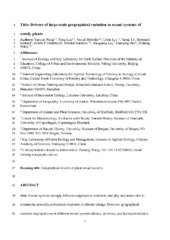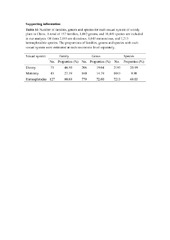| dc.contributor.author | Wang, Yunyun | |
| dc.contributor.author | Lyu, Tong | |
| dc.contributor.author | Shrestha, Nawal | |
| dc.contributor.author | Lyu, Lisha | |
| dc.contributor.author | Li, Yaoqi | |
| dc.contributor.author | Schmid, Bernhard | |
| dc.contributor.author | Freckleton, Robert | |
| dc.contributor.author | Dimitrov, Dimitar | |
| dc.contributor.author | Liu, Shuguang | |
| dc.contributor.author | Hao, Zhanqing | |
| dc.contributor.author | Wang, Zhiheng | |
| dc.date.accessioned | 2020-06-19T12:52:21Z | |
| dc.date.available | 2020-06-19T12:52:21Z | |
| dc.date.issued | 2020 | |
| dc.Published | Wang, Lyu, Shrestha N, Lyu L, Li, Schmid B, Freckleton R, Dimitrov D, Liu, Hao Z, Wang Z. Drivers of large‐scale geographical variation in sexual systems of woody plants. Global Ecology and Biogeography. 2020;29(3):546-557 | eng |
| dc.identifier.issn | 1466-8238 | |
| dc.identifier.issn | 1466-822X | |
| dc.identifier.uri | https://hdl.handle.net/1956/22773 | |
| dc.description.abstract | Aim: Sexual systems strongly influence angiosperm evolution and play important roles in community assembly and species responses to climate change. However, geographical variation in proportions of different sexual systems (dioecy, monoecy and hermaphroditism) in response to changes in climate, life‐history traits and evolutionary age remains poorly understood. Here, we map the geographical variation in proportions of different sexual systems and hypothesize that the prevalence of hermaphrodites increases with aridity owing to their advantages in colonizing harsh environments, whereas dioecy is most successful in humid regions with tall‐canopy vegetation and old floras. Location: China. Time period: Current. Major taxa studied: Woody angiosperms. Methods: Using data on sexual systems and distributions of 10,449 woody species in China, we estimated the proportions of different sexual systems in local floras (50 km × 50 km grid cells). Spatial linear models, phylogenetic general linear models and structural equation models were used to compare the relative influences of climate, plant height and evolutionary age on geographical variation in proportions of different sexual systems. Results: We found contrasting geographical patterns in the proportions of different sexual systems. The proportions of dioecy and monoecy increased with plant height and were highest in humid regions with older floras, whereas that of hermaphroditism decreased with plant height and was highest in arid regions with younger floras. Plant height was the strongest correlate of sexual system frequency. Climate influenced sexual system frequency both directly and indirectly via its effects on plant height. Main conclusions: Our study provides the first continuous map of sexual system composition in woody floras over a large spatial scale. Our findings suggest that mature plant height, reflecting plant longevity, dominates geographical variation in sexual systems and that the proportions of different sexual systems in local floras might reflect their correlated evolution with traits in response to climate changes. | en_US |
| dc.language.iso | eng | eng |
| dc.publisher | Wiley | eng |
| dc.title | Drivers of large‐scale geographical variation in sexual systems of woody plants | eng |
| dc.type | Peer reviewed | en_US |
| dc.type | Journal article | en_US |
| dc.date.updated | 2020-01-20T12:29:26Z | |
| dc.description.version | acceptedVersion | |
| dc.rights.holder | Copyright 2019 John Wiley & Sons Ltd | eng |
| dc.identifier.doi | https://doi.org/10.1111/geb.13052 | |
| dc.identifier.cristin | 1774655 | |
| dc.source.journal | Global Ecology and Biogeography | |
| dc.source.pagenumber | 546-557 | |
| dc.identifier.citation | Global Ecology and Biogeography. 2020;29(3):546-557 | |
| dc.source.volume | 29 | |
| dc.source.issue | 3 | |

